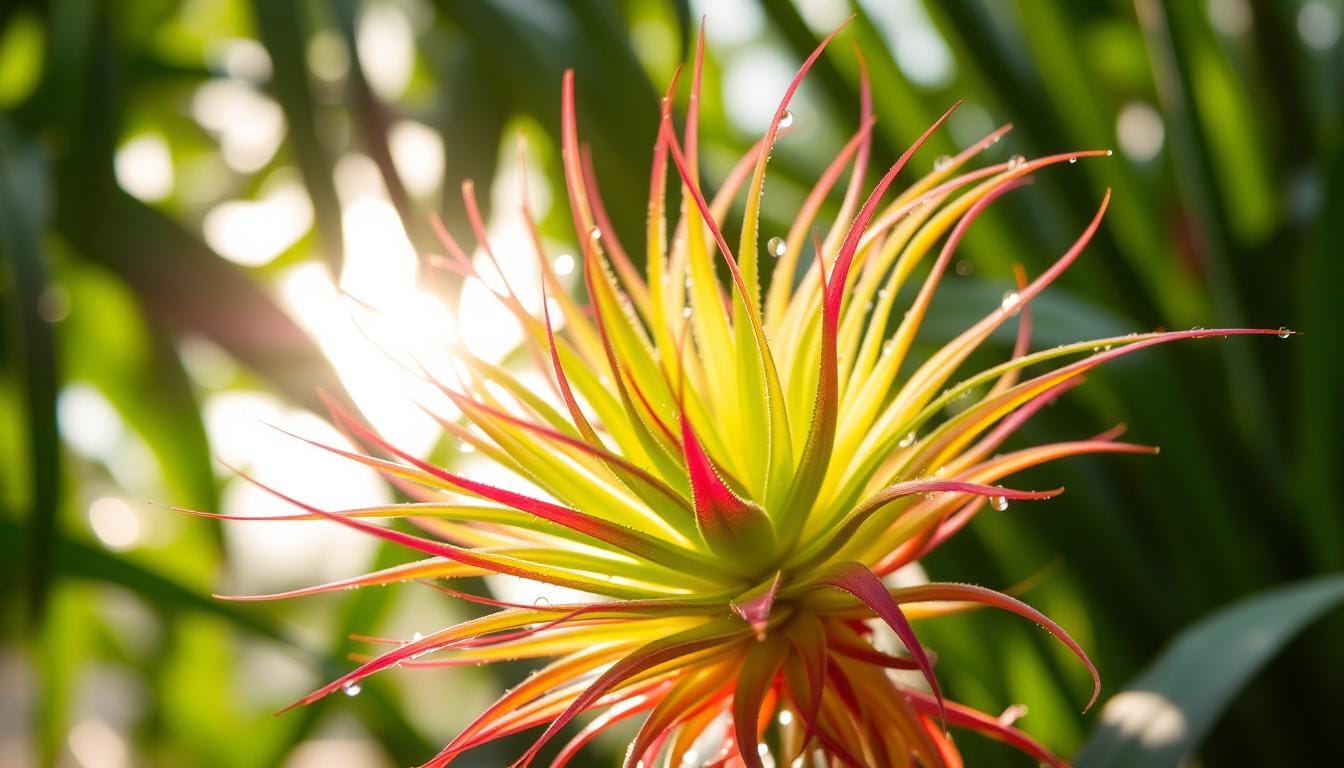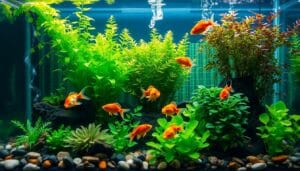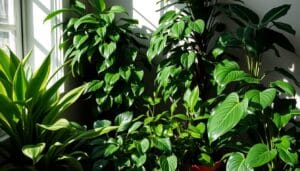Air plants, also known as Tillandsia, are unique epiphytes loved by many. They thrive in tropical areas without soil. Instead, they get water and nutrients through their leaves.
Knowing how to care for air plants is key to growing them well. This includes the right light, watering, and fertilizing. Learning these tips can help your air plants grow lush and bloom beautifully.
Key Takeaways
- Air plants need bright, indirect sunlight or fluorescent lighting for best growth.
- Too much direct sunlight can dry out air plants.
- It’s important to water them right, with thorough soaking and misting.
- They do well in temperatures between 50-90 degrees Fahrenheit.
- Watching for blooms and new growth is important for their health.
By learning about air plants’ needs, you can make a beautiful indoor or outdoor space. Check out the essential care tips to help your air plants thrive. They’ll add a tropical touch to your home.
Understanding Air Plants: A Unique Species of Tillandsia
Air plants, also known as Tillandsia, are a special group of plants. They don’t need soil to grow. Instead, they get their nutrients and water from the air around them.
What Makes Air Plants Different from Other Houseplants
Air plants belong to the Bromeliad family. They have special leaves called trichomes that help them absorb water and nutrients. This lets them grow on trees, rocks, and other surfaces, making them great for indoor and outdoor spaces.
Natural Habitats and Growth Patterns
Air plants come from many places, like Northern Mexico and South America. They live in different environments, from wet forests to dry deserts. This variety leads to many different species and growth patterns.
Types of Air Plants: Mesic vs. Xeric
- Mesic air plants come from places with moderate moisture. They look smoother, shinier, and greener.
- Xeric air plants live in dry places. They have a fuzzier, duller look and are often greyish-green.
Knowing the difference between mesic and xeric air plants is key. It helps you care for them properly and keep them healthy and colorful.
“Air plants are recognized for their ability to absorb water rapidly through specialized cells called trichomes on their leaves.”
There are over 650 types of Tillandsia air plants. They come in many shapes and colors, fitting any style or space. Their unique features and beauty make them a great choice for any room or garden.
Do Air Plants Need Sun? Light Requirements Explained
Understanding the light needs of air plants is key to their care. These plants, known as Tillandsia, live on air and need little soil. Their light needs vary by species.
Most air plants like bright, indirect light. Xeric types, with thick leaves, can handle more sun. But mesic types, with thinner leaves, need more shade. Place indoor air plants 5 feet from a sunny window.
For artificial light, air plants need 12 hours of “daylight” a day. Use full-spectrum fluorescent or LED grow lights. Good light is vital for their health and growth.
| Air Plant Type | Light Requirements |
|---|---|
| Xeric | Tolerates direct morning sun |
| Mesic | Requires more shade and indirect light |
Watch your air plants and adjust their light as needed. Too much sun can cause damage. By meeting their air plant light requirements, you ensure their health and beauty.
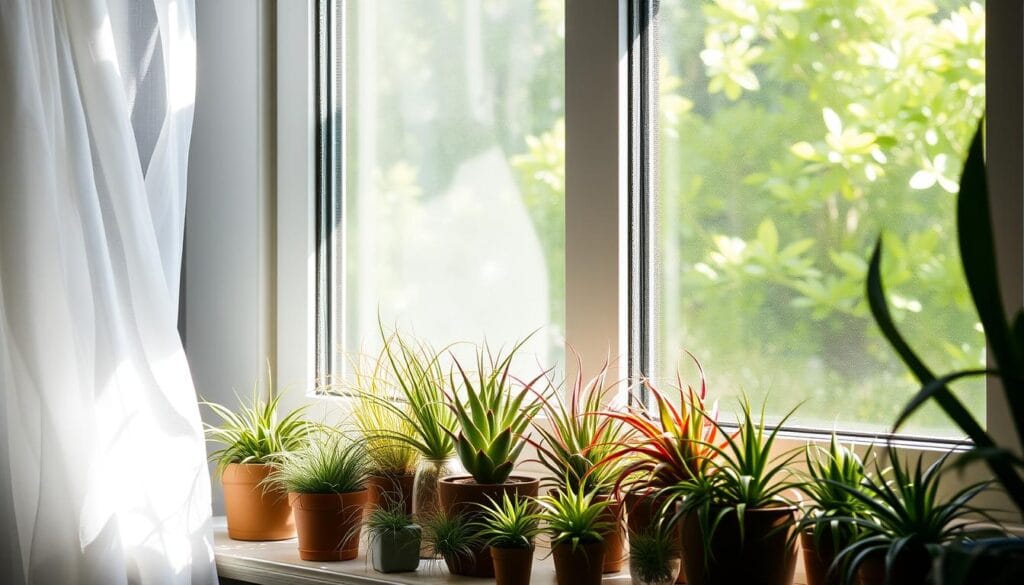
Optimal Growing Conditions for Air Plants
Caring for air plants means paying close attention to their needs. They need the right temperature, humidity, and air flow to grow well. Making sure their environment is just right is key to their success.
Temperature Requirements
Air plants love warmth, best between 50-90°F (10-32°C). They can live outdoors all year in places that don’t freeze, like USDA Hardiness Zone 9 or warmer. But indoors, keep them away from cold spots to avoid harm.
Humidity Levels
High humidity is great for air plants. If your home is dry, a humidifier can help. Their leaves have special hairs that soak up water and nutrients, making moisture vital for their health.
Air Circulation Needs
Good air flow is important to prevent moisture from causing rot. Make sure your air plants get enough air, especially after you water them. A bit of air movement, like from a fan or near a window, helps them grow well.
| Optimal Air Plant Conditions | Requirement |
|---|---|
| Temperature | 50-90°F (10-32°C) |
| Humidity | High humidity levels |
| Air Circulation | Gentle air movement |
By meeting their needs for air plant temperature, air plant humidity, and air plant environment, you can help them thrive. These plants are not only beautiful but also resilient.
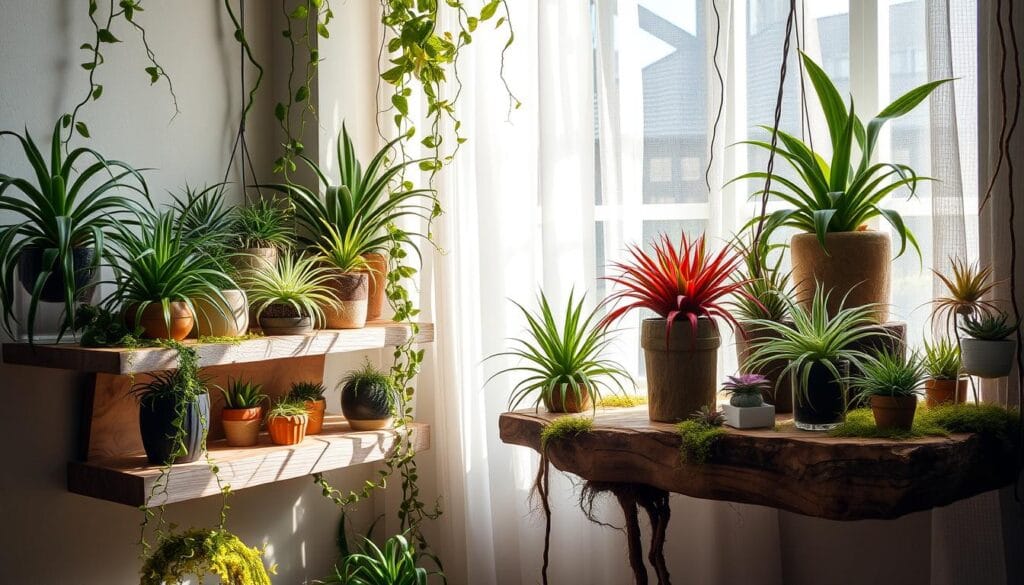
Essential Watering Techniques for Air Plants
Watering air plants right is key to their health and life span. The needs of these plants change based on their type and where they live. There are two main ways to keep them hydrated: misting and soaking.
Mesic air plants like more moisture. Start by soaking them in water for 15-30 minutes, 1-2 times a week. Xeric air plants, being more drought-tolerant, might only need soaking once a week or every 10 days.
For misting, lightly spray your air plants every few days, especially in dry places. This keeps the humidity right. But, misting alone might not give them enough moisture.
- Soak mesic air plants for 15-30 minutes, 1-2 times per week
- Soak xeric air plants every 7-10 days
- Mist air plants lightly every few days to maintain humidity
It’s vital to ensure air plants get good air flow and dry out fully after watering. Don’t water them late in the day to avoid messing with their gas exchange at night. Use water without chlorine, like filtered, spring, or well water, for the best results.
By using these watering tips, your air plants will thrive and look great for years.
Proper Feeding and Fertilization Methods
To keep your air plants healthy and growing well, you need to feed and fertilize them right. [https://savvygardening.com/air-plant-care/] Fertilize them from April to September to help them bloom and grow new pups. Use a Bromeliad fertilizer or a balanced liquid fertilizer (10-10-10) at half strength.
When to Fertilize
Feeding your air plants regularly is important. Fertilize them once a month in winter and every two weeks in spring and summer. This keeps them getting the nutrients they need to grow and thrive.
Best Fertilizer Types
The best fertilizer for air plants has an NPK value of 17-8-22. The ideal pH for air plant fertilizers is between 5.5 and 6. These specific values meet the needs of these unique plants.
Application Methods
You can mix fertilizer into the water for misting or soak the plants in it. When misting, spray until the plants are wet to spread the nutrients evenly. This method is great for indoor plants that don’t get many nutrients.
| Fertilizer Type | NPK Value | pH Range | Application Method |
|---|---|---|---|
| Bromeliad Fertilizer | 17-8-22 | 5.5 – 6.0 | Misting or Soaking |
| Balanced Liquid Fertilizer | 10-10-10 | 5.5 – 6.0 | Misting or Soaking |
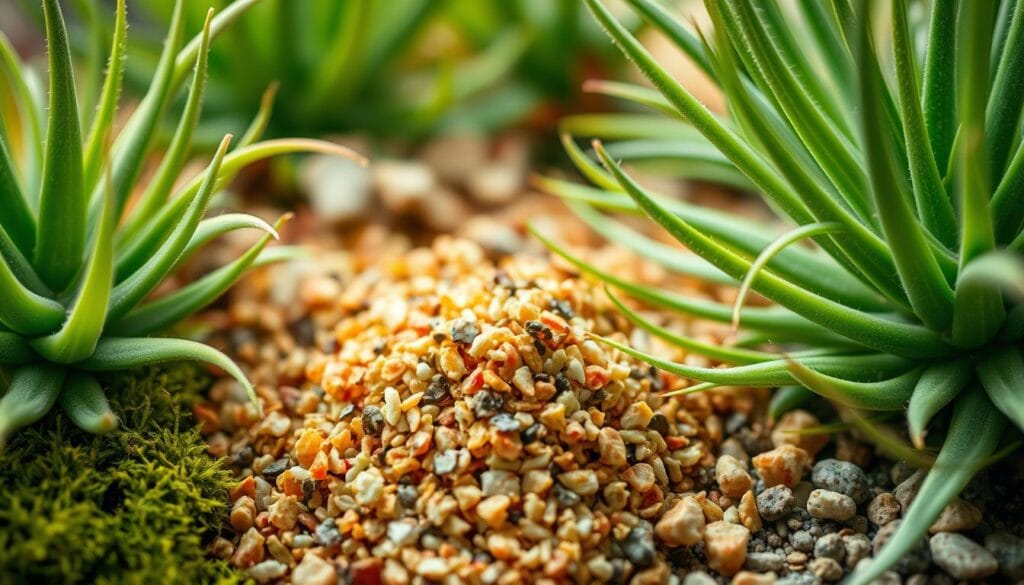
Remember, regular and proper fertilization is key for your air plants’ health and growth. Watch for signs of nutrient lack, like pale leaves or no new growth. Adjust your feeding schedule if needed.
Common Air Plant Problems and Solutions
Air plants are easy to care for, but they can still face some challenges. Knowing about these issues and how to fix them helps keep your air plants healthy and thriving.
Overwatering is a big problem for air plants, causing rot. This is the main reason for air plant rot. To avoid this, water your air plants once a week. Some types might need even less water.
Underwatering can also cause problems, making leaves turn brown and crispy. Air plants need 4-6 hours of indirect light each day to do well. If they don’t get enough light, they might turn yellow because they’re not making enough chlorophyll.
Good air circulation is key for air plants. Without it, moisture can get trapped, leading to rot. Make sure your air plants have enough space for air to move around them.
- Overwatering can lead to devastating rot in air plants.
- Underwatering causes crispy, brown leaf tips.
- Lack of air circulation can trap moisture and cause problems.
Pests like mealybugs and scale insects are another common problem. These pests attack weak plants, especially in low humidity and high temperatures. If your air plant gets pests, isolate it and treat it with pesticides. Try to avoid using pesticides if you can.
Check your air plants often for pests or diseases. Fix any problems quickly to keep your plants healthy and thriving.
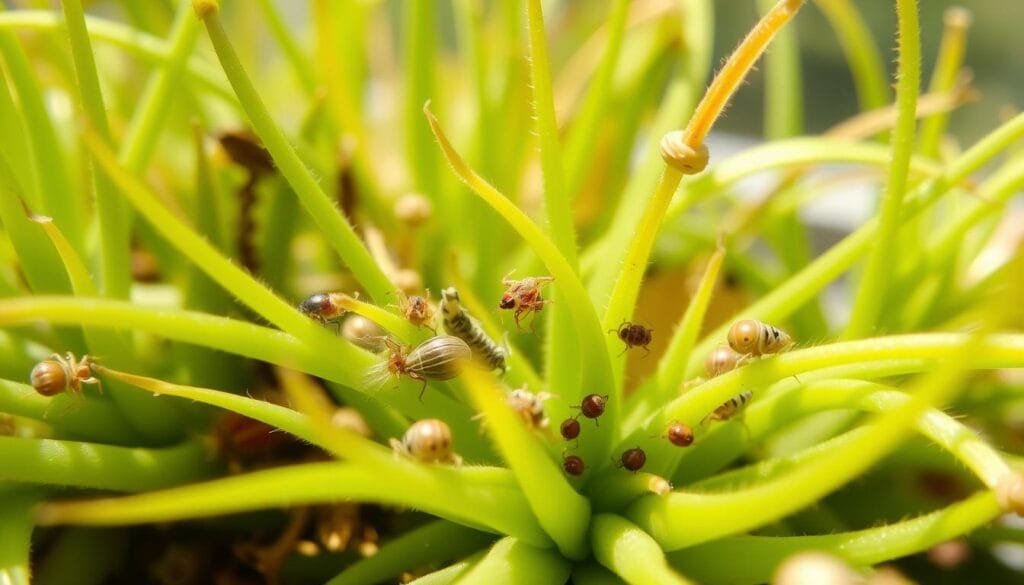
By understanding and fixing these common air plant problems, you can keep your Tillandsia collection looking great. Enjoy their beauty for many years with proper care.
Propagation and Growth Cycles
Air plants, also known as Tillandsia, have a unique life cycle. It’s both fascinating and rewarding to watch. These epiphytic plants from the bromeliad family bloom just once in their lifetime. They produce vibrant, long-lasting flowers that captivate any plant enthusiast.
Understanding the Blooming Process
The blooming cycle of air plants takes 1 to 3 years. During this time, the plant develops its signature flower. The flower can be vibrant reds and oranges or delicate pinks and purples. Once the bloom has faded, the mother plant starts growing pups or offshoots.
Handling Pups and Offshoots
- Allow the air plant pups to grow to about one-third the size of the parent plant before separating them.
- Alternatively, you can leave the pups attached to the mother plant. This allows them to form a clump or cluster over time.
- With proper care, air plants can live for 2-5 years. But, their ability to produce air plant propagation through pups means they can grow indefinitely.
The air plant flowers may last a few days or several months. This depends on the species. But, their mesmerizing display shows the resilience and adaptability of these unique plants.
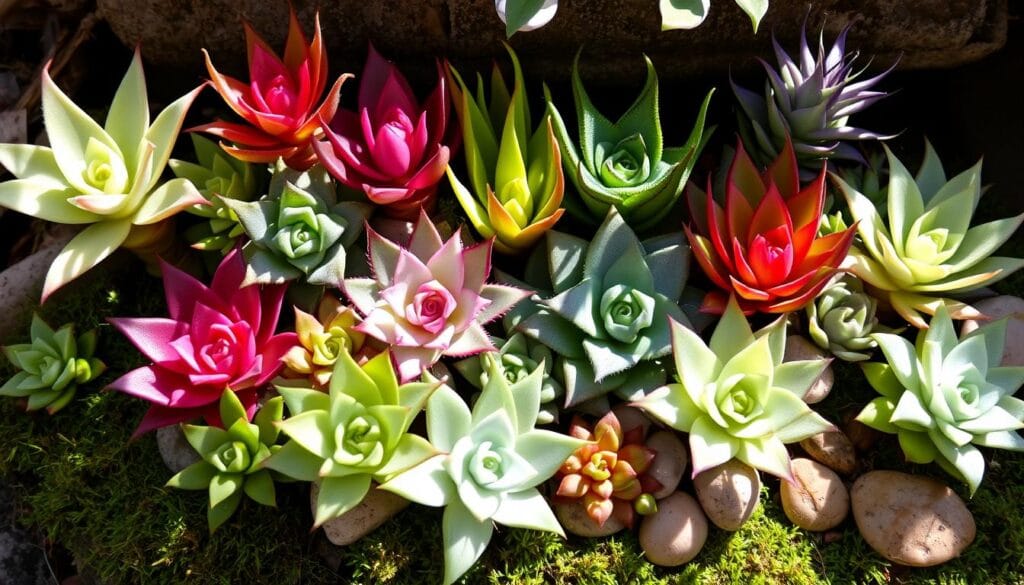
“Air plants are truly remarkable, with their ability to thrive without soil and their captivating blooming cycles. Watching them grow and produce new pups is a true joy for any plant enthusiast.”
By understanding air plant propagation and growth cycles, your indoor garden stays vibrant. It will always have new growth and vibrant air plant flowers.
Creative Display Ideas and Mounting Options
Air plants, also known as Tillandsias, are gaining popularity. They thrive without soil and offer many display options. You can show them off in hanging glass terrariums or on driftwood. The choices are endless.
One great thing about air plants is how they can be mounted. Just make sure to avoid materials that hold moisture, like fabric or moss. They can cause rot. Instead, use fishing line, air plant holders, or even old benches for unique displays.
- Incorporate air plants into backyard fence panels or hang them from trellis panels to create a stunning vertical garden.
- Combine air plants with varying leaf shapes, colors, and textures to craft captivating arrangements.
- Suspend air plants from branches or incorporate them into air plant mobiles and chandeliers for a touch of whimsy.
Air plants offer endless creative options. Whether you like modern or rustic styles, there’s a display for you. Try different species and mounting methods to make your spaces beautiful.
With the right care, air plants can live for years. They’re a great choice for adding greenery to your home. Let your creativity shine as you create unique air plant displays.
Conclusion
Successful air plant care means knowing their special needs. This includes the right light, water, and food. By giving them what they need, air plants can grow well and add beauty to your home.
Keeping your air plants in the best condition is key. Whether you’re new to air plants or have been caring for them for a while, knowing the right air plant care tips is important. This way, your air plants will thrive and make your home more beautiful.
Learning how to care for air plants can bring many benefits. They can improve the air you breathe and make you feel better mentally. With a bit of care, your air plants can bring joy and show the beauty of nature in your home.


